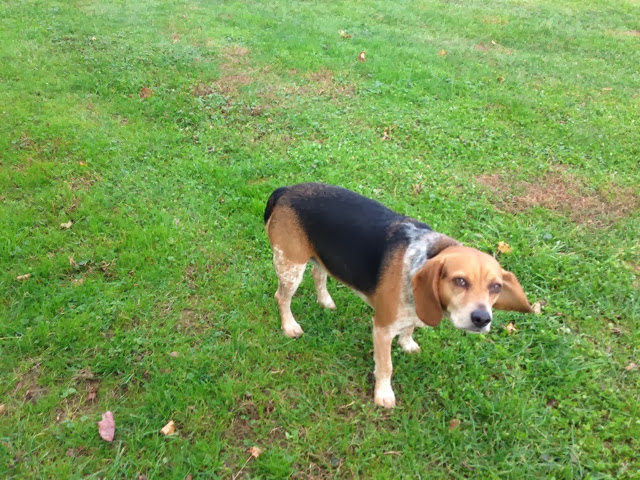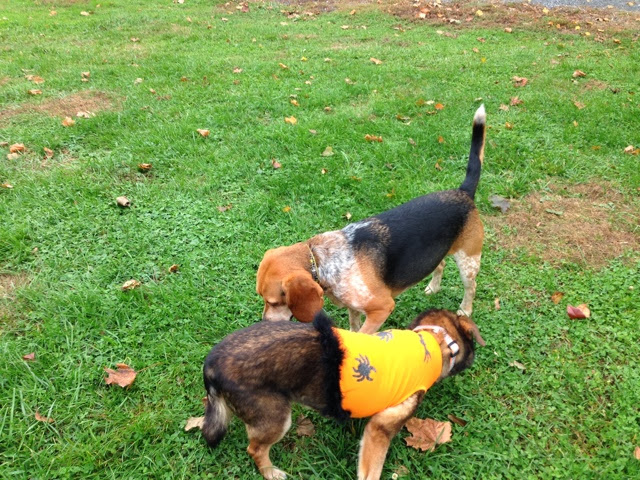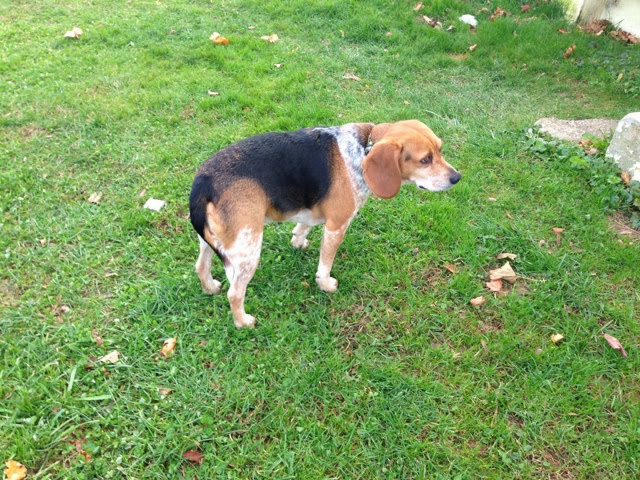I woke up this morning to a Jekyll pup with a tail droop.
That normal breed specific cotton tipped tail was not at attention and flickering back and forth at light speed with its normal anxiously awaiting breakfast fervor.
The front half of Jek was smiling, wiggling, and sad-eyed yearning mutely for a morsel of forgotten yesterdays cat food, but the back half...well, it was pitifully just hanging from his rump.
Where had his little personality possessed white flag gone?
Well, sometime between late yesterday afternoon and this morning it lost its mo-jo.
After a quick home based physical exam I quickly confirmed that everything was running perfectly.
- He was walking normally.
- Peeing/Pooping normally.
- Had normal anal tone.
- No pain on tail jack, (this is moving the tail straight forward so that the tail tip is pointing towards the head). Please don't try this without a vet showing you!!
- No pain on spinal palpation.
- No signs of trauma around the base of the tail area.
 |
| Poor Jekyll,,there's no pep in your step without your little tail wag! |
Of the working and hunting dogs the most common predisposing factors to this condition were prolonged cage transport, swimming, prolonged periods of recent hard workouts, or exposure to cold/wet weather.
For Jekyll I can testify that it is getting colder here in Southern Pennsylvania, but he has yet to put in a full days work of doing anything short of lounging. And, of course, he would never be subjected to prolonged cage periods, or cold temperatures.
When I see a patient arrive with the same set of concerns I will first do an exam. I am looking for any signs of neurologic disease or injury, like myositis (inflammation of muscle), tendonitis (inflammation of the tendon), tail avulsion (pulling the spinal cord and vertebrae to the point of injury), or any other condition that could cause pain, or swelling around the tail. If any of these are found we treat for them. I will add that I also check anal glands. Any condition that can cause pain around the tail will cause the pet to not want to lift their tail.
In almost all cases I am not able to find a cause or a reason for the tail droop.
So, in all of these cases I have told owners to take a conservative approach, and watch and wait and see. In all cases the tail was back at full mast within a day or two. There are some mentions of adding a non-steroidal anti-inflammatory to these patients, but I always feel that a pet should only be medicated for a condition that justifies the risk and potential side effects that any and all drugs inherently have.
 |
| The old Jekyll (picture from last week). |
Here's looking at you Jekyll kid, tail wag, floppy ears, sad face or not, I can't resist you!



Leia (A chihuahua!!) got "dead tail syndrome" as my vet referred to it. I thought her tail was broken, but she made a full recovery. :)
ReplyDeleteHi Y'all!
ReplyDeleteHope you get your tail back up there, Jekyll!
Y'all come by now,
Hawk aka BrownDog
My Beagle suddenly acquired this yesterday! I had no idea what was going on and found your site when I Googled "beagle droopy tail". I called her vet and was told to just give her a few days and it should go away, otherwise to bring her in. Thank you for having this information available... I had never heard of such a thing!
ReplyDeleteMy beagle male has been this way for a few days now. I feel so sorry for him, he wants to run bunnies so bad but I know he needs to rest so his tail to come back to wagging. I miss his wagging tail. I've read it can take a few weeks in some cases is this true.
ReplyDeleteI thought it was a nutritional deficiency, her tail has been curled under her legs for some months and has a bald patch it (the tail) has gotten thin too now She also has swollen front paws from too much wet food my mother overfeeds her with, a yeast infection (a strident Irish idiot) the vet has told her to stop it but she reverts to overfeeding within weeks each time. This cruelty has its origins in an inheritance dispute This poor dog needs help, its not her fault her owner is a greedy little slag, Irish shouldn't own pets
DeleteThanks for this post! My beagle was digging and running around on our wooded lot like a maniac yesterday, and now her tail looks just like this. She's clearly not in any pain, still running around, and palpating the tail does not elicit any yips or howls, so I'm going to follow your guidance and see if a few days rest does the trick. You're probably saving me from an expensive trip to the ER vet. Thanks!
ReplyDelete